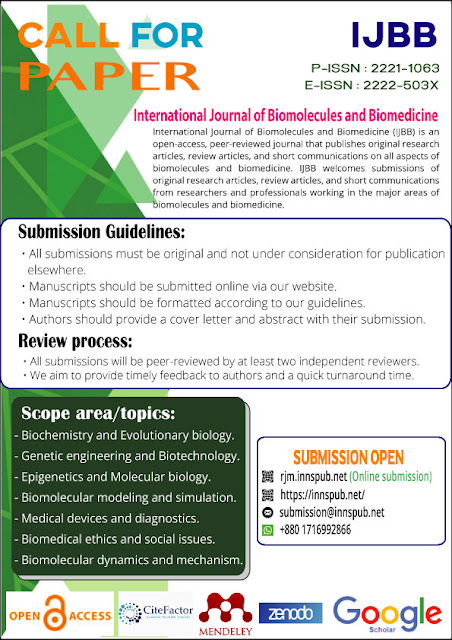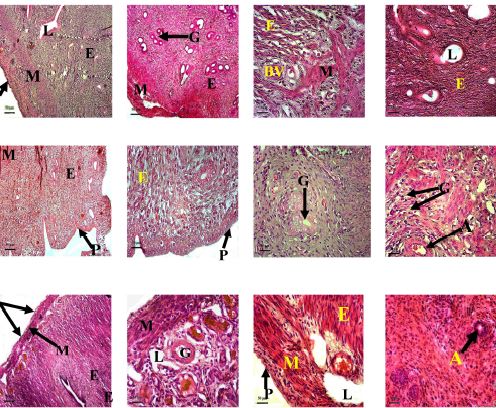Efe Endurance Ahama,
Omewomano Peace Onyilo, Emmanuel Agbamu, Igho Emmanuel Odokuma , Ijeoma Favour
Ossai and Oroghene Clinton Ogorugba, from the different institute of
the Nigeria. wrote a research article about, Turmeric Extract Effects
on Rat Ovary and Uterus, entitled, Histologic sequelae following exposure
to turmeric extract on wistar rats ovary and uterus.This research paper
published by the International Journal of Biomolecules and Biomedicine | IJBB.
an open access scholarly research journal on Biomedicine. under the affilition
of the International Network For Natural Sciences | INNSpub. an open access
multidisciplinary research journal publisher.
Abstract
The regular and single use of turmeric in reference to the reproductive system following several review is conflicting, and its effect has not been fully ascertained. The study therefore espoused the histologic sequelae following exposure to turmeric extract on wistar rats ovary and uterus. Ethical clearance was sought from the Research and Ethics Committee in the Faculty of Basic Medical Sciences of the Delta State University prior to the commencement of this research. 24 wistar rats divided into 4 groups of 6 rats each. Group A was the control group while groups B, C and D were the treated groups that received 500, 1000 and 1500mg/kg of turmeric extract respectively. Animals were also sub-sectioned, labeled accordingly into 7th, 14th and 21st days respectively for easy identification and treatment or administration. At the end of each experimental days, animals were weighed and euthanized by cervical dislocation. Ovaries and uterus were dissected and fixed in 10% formal saline solution, following regulated histologic procedures. Prepared Slides were viewed using a digital microscope. The micrographs obtained revealed deleterious effect on the histology and cytology of the ovary and uterus following treatment of turmeric. The observed histological distortions to the ovary and uterus have most likely arisen from repeated exposure to tumeric extract; this has proven turmeric to be an harmful substance to the female reproductive system especially women of child bearing age and the regular and continuous consumption of these agent should be regulated.
Read more : Hepatitis B Antigen in Coleus forskohlii Expression| InformativeBD
Introduction
Turmeric is a commonly used spice, popularly known as Curcuma as its active ingredient. It is rhizomatous and herbaceous plant use to attain certain health ameliorating effect in humans (Lestari and Indrayanto, 2014). It possesses antioxidant, anti-inflammatory, antimicrobial, anti-angiogenic and anticancer effects, which ascertain it therapeutic property (Ahmad et al., 2020; Bahrami et al., 2020). It can also boost immunocompetent cells and produce inflammatory cytokines (Moody et al., 2020). On the otherhand its mechanism of action remain unknown in respect to reproduction, but it is a known fact that tumeric is phytoestrogenic in nature (Bachmeiri et al., 2010). It’s widely consumed as a traditional medicine despite the lack of awareness of its safety or toxic effects especially to the reproductive system (Jeber and Tawfeek, 2012; Thakur et al., 2009; Ilyas et al., 2019).
Reproduction is a vital
biological process for maintenance of species. However, exogenous substances
such as herbs can be used to suppress or promote fertility (Harat et al.,
2008). A study has proven the beneficial antioxidative effect of curcumin on
the testis and ovaries (Jeber and Tawfeek, 2012). In the ovaries, turmeric
promotes ovarian viability, folliculogenesis, fecundity and response to
hormones. Some studies have also reveal curcumin to mediate cell cycle arrest
in many different tumour cells through the regulation of several proteins and
cascades (Park et al., 2002; Aggrawal et al., 2006). Jeber and Tawfeek in their
study also affirmed to the protective effect of curcumin as against potassium
dichromate induced ovary. The beneficial effect of turmeric on dysmenorrhea and
endometriosis, as a therapeutic major by way of reducing endometrial cells
lining is also documented in the uterus (Utami et al., 2020; Zhang et al.,
2013)
Apart from the
beneficial effects of curcumin on female reproduction, ominious effects such as
decrease of gonadotropin hormones and inhibition of the estrous cycle have been
documented (Thakur et al., 2009). Studies have also proven turmeric to be an
infertility agent with discoveries showing its relaxant properties that reduces
the level of oxytocin thereby reducing the contraction of the uterus which is
not healthy for women of childbearing age (Ittipanichong et al., 2003; Manvizhi
et al., 2020). Morealso, turmeric has been shown to cause degenerative features
of the graafian follicles and germinal epithelium of the ovaries with presence
of rudimentary corpus luteam cells (Ray et al., 2011). Considering the
aforementioned treatise reviewed, with contracdictory (safety and toxic) effect
of the use of turmeric on female reproduction which is not fully studied or
ascertained coupled with scanty reports on the anatomic histoarchitecture of
uterus and ovary following exposure to the single use of turmeric. The study
therefore evaluated the histologic sequelae following exposure to turmeric
extract on wistar rats ovary and uterus.
Reference
Aggarwal S, Ichikawa H,
Takada Y, Sandur SK, Shishodia S, Aggarwal BB. 2006. Curcumin
(diferuloylmethane) down-regulates expression of cell proliferation and
anti-apoptotic and metastatic gene products through suppression of IκBα kinase
and Akt activation. Molecular Pharmacology 69, 195 – 206.
Ahama EE, Odokuma
EI. 2022. Histomorphological Effects of Oral Nicotine Administration on
the Testes of Adult Wistar Rats. Journal of Chemical Health Risks. DOI:
10,22034/ jchr.2022.1949064.1488
Ahmad RS, Hussain MB,
Sultan MT, Arshad MS, Waheed M, Shariati MA, Plygun S, Hashempur MH. 2020.
Biochemistry, Safety, pharmacological activities and clinical application of
turmeric: A mechanistic review. Evidence Based complementary and Alternative
Medicine 7656919
Bachmeier BE, Mirisola
V, Romeo F, Generoso L, Esposito A, Dell’eva R, Blengio F, Killian PH, Albini
A, Pfeffer U. 2010. Reference profile correlation reveals estrogen-like
transcriptional activity of curcumin. Cellular Physiology and
Biochemistry 26, 471 – 482.
Bahrami A, Sathyapalan
T, Moallem SA, Sahebkar A. 2020. Counteracting arsenic toxicity: Curcumin
to the rescue. Journal of Harzardous Material 400, 123160.
Emani B, Farzaneh S,
Ghorani V, Boskabady MH. 2017. Relaxant effect of Curcuma longa on rat
tracheal smooth muscle and its possible mechanisms. Pharmaceutical Biology 55(1), 2248
– 2258.
Eze-Steven PE. 2019.
Histopathological Investigations of Curcuma longa (Turmeric)
and Zingiber officinale (Ginger) on rats with Monosodium
Glutamate-induced Leiomyoma 7(1), 9-15
Harat ZN, Sadeghi MR,
Kamalinejad M, Eshraghian MR. 2008. Immobilization effect of Ruta
graveolens L. on human sperm: A new hope for male contraception.
International Journal of Ethnopharmacology 115, 36-41.
Ibraheem BO,
Oluwagbenga OI, Tawa OO, Jacob OO, Babatunde A. 2018. Effects of organic
turmeric on liver integrity and oxidative stress of the brain in rabbits
exposed to ultraviolet radiation. International Journal of Environment,
Agriculture and Biotechnology 3(3), 838 – 845
Ilyas S, Hutahaean S,
Elimasni E, Panjaitan SRN. 2019. Effect of turmeric rhizome extract on the
kidney histology of preeclampsia rats. Earth and Environmental Science 305, 012078.
Itthipanichong C,
Ruangrungsi N, Kemsi W, Sawasdipanich A. 2003. Antipasmodic effects of
curcuminoids on isolated guinea pigs ileum and rat uterus. Journal of the
Medical Association of Thailand 299 – 309.
Jeber ZK, Tawfeek
FK. 2012. Effect of turmeric oil in reproduction efficiency of immature
female rats exposed to oxidative stress induced by potassium dichromate. Journal
of Pharmacy and BioAllied Sciences 9-13.
Lestari MI, Indrayanto
G. 2014. Curcumin. Profile of drug substances, Excipients and Related
Methodology 39, 113-204.
Manvizhi S, Sabitha SV,
Aniket K, Margaret SFX. 2020. Effect of curcumin on the contraction of
isolated goat uterus. International Journal of Basic Clinical
Pharmacology 10(1), 81.
Marchiani A, Rozzo C,
Fadda A, Delogu G, Ruzza P. 2014. Curcumin and curcumin-like molecules
from spice to drug. Current medicinal Chemistry 21, 204 – 222.
Mohammed A, Wudil AM,
Alhassan AJ, Muhammad IU, Idi A, Abdulmumin Y. 2016. Acute and sub chronic
toxicity studies of aqueous, methanolic and n-Hexane root extracts of Curcuma
longa L. on albino rats. British Journal of Pharmaceutical Research 14(2), 1
– 8.
Moody R, Wilson K,
Jaworowski A, Plebanski M. 2020. Natural compounds with potential to
modulate cancer therapies and self-reactive immune cells. Cancers (Basel) 12, 673
Naz RK. 2011. Can
Curcumin Provide an Ideal Contraceptive? Molecular Reproduction &
Development 78, 116 – 123
Park MJ, Kim EH, Park
IC, Lee HC, Woo SH, Lee JY, Hong YJ, Rhee CH, Choi SH, Shim BS, Lee SH, Hong
SI. 2002. Curcumin inhibits cell cycle progression of immortalized human
umbilical vein endothelial (ECV304) cells by up-regulating cyclin-dependent
kinase inhibitor, p21WAF1/CIP1, p27KIP1 and p53. International Journal of
Oncology 21, 379 – 384.
Raj A, Singh A, Sharma
A, Singh N, Kumar P Bhatia V. 2011. Antifertility activity of medicinal
plants on reproductive system of female rat. International Journal of
Bio-Engineering Science and Technology 2, 44 – 50.
Rauf M, Osman C, Sevil
E, Asli C, Nese B. 2018. Beneficial effects of curcumin and capsaicin on
cyclophosphamide-induced premature ovarian failure in a rat model. Journal of
Ovarian Research 11(33).
Reddy PS, Begum N,
Mutha S, Bakshi V. 2016. Beneficial effect of curcumin in Letrozole
induced polycystic ovary syndrome. Asian Pacific Journal of Reproduction 5(2), 116
– 122.
Thakur S, Bawara B,
Dubey A, Nandini D, Chauhan NS, Saraf DK. 2009. Effect of Carum carvi and
Curcuma longa on hormonal and reproductive parameter of female rats.
Internaional Journal Phytomedicine 1, 31 – 38.
Utami RB, Damayanti DF,
Rodiah D. 2020. The effectiveness of Curcuma longa drink in
decreasing the intensity of Dysmenorrhea. Biomedical and Phamacology
Journal 13(4), 2055 – 2060
Wang X, Zheng M, Liu J,
Huang Z, Bai Y, Ren Z, Wang Z, Tian Y, Qiao Z, Liu W, Feng F. 2017.
Differences of first pass effect in the liver and intestine contribute to the
stereoselective pharmacokinetics of rhynchophylline and isorhynchophylline
epimers in rats. Journal of Ethnopharmacology 209, 175 – 183.
Yan F, LaMarre JM,
Rohrich R, Wiesner J, Jomaa H, Mankin AS, Fujimori DG. 2010. RlmN and Cfr
are radical SAM enzymes involved in methylation of ribosomal RNA. Journal of
the American Chemical Society 132, 3953 – 3964.
Yan Z, Dai Y, Fu H,
Zheng Y, Bao D, Yin Y, Chen Q, Nie X, Hao Q, Hou D, Cul Y. 2018. Curcumin
exerts a protective effects against premature ovarian failure in mice. Journal
of Molecular Endocrinology 60(3), 261 – 271.
Zhang Y, Cao H, Yu Z,
Peng H, Zhang C. 2013. Curcumin inhibits endometrial cells by reducing
estradiol production. Iranian Jouranl of Reproducive Medicine 11(5), 415
– 422.
Source : Histologic sequelae following exposure to turmeric extract on wistar rats ovary and uterus












%20in%20full.JPG)


0 comments:
Post a Comment